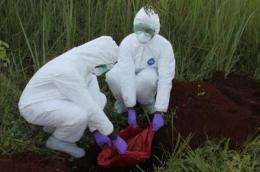Health experts narrow the hunt for Ebola

Response efforts to outbreaks of Ebola hemorrhagic fever in Africa can benefit from a standardized sampling strategy that focuses on the carcasses of gorillas, chimpanzees and other species known to succumb to the virus, according to a consortium of wildlife health experts.
In a recently published study of 14 previous human Ebola outbreaks and the responses of wildlife teams collecting animal samples, the authors of the new study conclude that most efforts to collect samples from live animals (i.e. rodents, bats, primates, birds) failed to isolate Ebola virus or antibodies. However, they found that collecting samples from animal carcasses during outbreaks was a more effective method for Ebola detection. The early detection of Ebola in animal populations near a human outbreak is crucial for learning more about this virus, which can strike human populations with a mortality rate of more than 80 percent.
"You can't test every single animal, so we used information from historical outbreaks to figure out how to help the field response team focus their effort," according to Wildlife Conservation Society (WCS) wildlife epidemiologist Sarah Olson, the lead author of the new report. "It turns out that carcass sampling yields a 50 percent chance of finding Ebola virus or antibodies compared to less than six percent when sampling free-ranging live animals."
The scientific consortium that participated in the study, published in an online issue of Emerging Health Threats, are key partners in PREDICT, part of USAID's Emerging Pandemic Threats Program that is improving global capacity to respond to emerging infectious diseases that originate in wildlife. PREDICT is led by the University of California at Davis, in partnership with Ecohealth Alliance, Global Viral Forecasting Initiative, the Smithsonian Institution, and the Wildlife Conservation Society.
"The Emerging Pandemic Threats program is a visionary investment by USAID to protect and improve global health because it has made it possible for us to, for the first time, pre-emptively, and on a global scale, identify novel pathogens in wildlife that could pose pandemic threats to humans," said Dr. Jonna Mazet, Director of PREDICT and Director of the One Health Institute at the University of California, Davis School of Veterinary medicine. "This study is a great example of how PREDICT is using science to improve our ability to detect lethal diseases, like Ebola."
The study was designed to develop a set of animal sampling recommendations to maximize the effectiveness of Ebola outbreak response efforts with limited resources. Specifically, the study was prompted by a 2011 outbreak near Kampala, Uganda, in which a 12-year-old girl died from Ebola hemorrhagic fever. PREDICT wildlife veterinarians were sent to the victim's village to screen wildlife as a potential source of the virus.
"This study digests over 30 years of accumulated knowledge so field teams can arrive informed and prepared," adds WCS epidemiologist and senior author, Damien Joly.
The authors also point to some scientific "loose ends" that can be incorporated into future animal sampling efforts during Ebola outbreak response. For instance, despite some evidence of Ebola in dogs and pigs, the number of samples acquired from these animals is limited to just two outbreaks; the authors recommend increasing the number of samples collected from these groups in the future to better determine their role in Ebola outbreaks. The study also confirms that while fruit bats should be a focus of investigation as a potential reservoir for Ebola, field teams need to be prepared to sample hundreds of bats because virus prevalence across all bats sampled to date is very low, estimated at 3 percent.
More information: "Dead or alive: animal sampling during Ebola hemorrhagic fever outbreaks in humans," Emerging Health Threats.
















